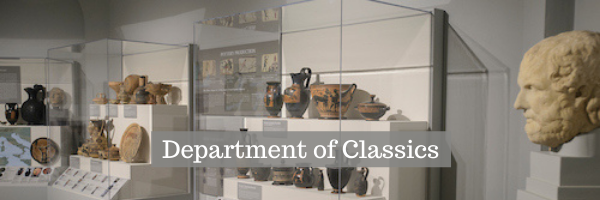
-

Archaeology Showcase (2024)
Jesse Tune, Jacqueline Frost DiBiasie-Sammons, Aileen Ajootian, Joseph Cruz, Karina Glenn, Greg Palculict, and Maggie Wallace
Professor Jesse Tune, UM Department of Sociology and Anthropology
"Moving to the Edge of the World: Ireland's First Peoples"Professor Jacqueline Frost DiBiasie-Sammons, UM Department of Classics
"Mapping Media: A bird's eye view of charcoal, chalk and ochre graffiti in Pompeii"UM Classics majors Mr. Joseph Cruz, Ms. Karina Glenn, Mr. Greg Palculict, Ms. Maggie Wallace
"To Rome and Back"Professor Aileen Ajootian, UM Department of Classics
"Young Herakles" -

University of Mississippi Archaeology Showcase 2022
Aileen Ajootian, Carolyn Freiwald, Annabelle Harris, Sydney Lynch, Sierra Thomas, Brad Cook, and Jacqueline DiBiasie-Simmons
Welcome
Dr. Aileen Ajootian, Professor, Department of Classics"The Artemis Sanctuary at Brauron in Roman Times: A Healing Cult ?"
Dr. Aileen Ajootian, Professor, Department of Classics"The Lives of Ancient Dogs"
Dr. Carolyn Freiwald, Associate Professor, Department of Sociology and Anthropology"Students and Charcoal: Observations From Ancient Graffiti in Pompeii"
Annabelle Harris, Sydney Lynch, Sierra Thomas, UM Classics majors"Swearing By Gold (in the UM Museum), An Update"
Dr. Brad Cook, Professor, Department of Classics"Writing Among the Dead: Charcoal Graffiti in Pompeian Tombs"
Dr. Jacqueline DiBiasie-Sammons, Assistant Professor, Department of Classics -

14 Black Classicists
Michele Valerie Ronnick
The Department of Classics is hosting a traveling photographic and historical exhibit called, “14 Black Classicists”. The exhibit, conceived and curated by Dr. Michele Valerie Ronnick of Wayne State University, reflects on the role of advanced education (and especially of the study of Classics) in building a free and prosperous Black community in the United States. Dr. Ronnick has collected the stories of nineteenth-century Black Americans who chose to pursue advanced education in Greek and Latin language and ancient history, literature and art, and went on to teach in the field. The exhibit is open until November 18th, Monday through Friday, 8 am to 7 pm in the Farrington Gallery on the first floor of Bryant Hall.
In addition to the exhibit, we will be hosting Dr. Ronnick for a talk on Thursday, November 3 at 5:30 in Bryant 209, with a reception and exhibit event preceding the talk, beginning at 4:00 in Farrington Gallery. Dr. Ronnick will provide “A Brief History of Black Classicism”. Monica Granderson-Little, who teaches in English at Jackson State University, will be delivering preliminary remarks that will help connect Dr. Ronnick’s talk and the exhibit to the broader history of Black education, with a particular focus on the history and the future of JSU.
Visitor and handicap parking for both events is available on the Lyceum Circle. ADA-compliant access to Bryant Hall is through the Fulton Chapel side door. If you have any questions, or if you require a disability related accommodation to fully participate in this event, please contact Molly Pasco-Pranger (mpranger@olemiss.eduor662-915-7097)
-

Death Comes to Oplontis: Victims of Mt. Vesuvius Reveal Life in 79 AD
Kristina Killgrove
Dr. Kristina Killgrove delivered a fascinating virtual lecture entitled “Death Comes to Oplontis: Victims of Mt. Vesuvius Reveal Life in 79 A.D.” The talk offered a rich supplement to current students in Dr. Jacqueline DiBiasie-Sammons’ Fall 2021 course, Art and Archaeology in Pompeii and Herculaneum, but was accessible to more general audience as well and had more that sixty attendees.
-

Shipwrecks and the Transport of Luxury in the Roman Mediterranean
Carrie Atkins
During the late Republic and early Empire, Rome had a voracious appetite for importing luxury objects from around the Mediterranean: spices from the Arabian Peninsula, sculptures and bronzes from Greece, glassware from Egypt and the Levant, and textiles from India, to list a few examples. Some of these so-termed luxuries have been preserved in shipwrecks in the Mediterranean, yet these objects only represent a small portion of the overall cargoes. By examining several Roman shipwrecks (ca 200 BCE – 200 CE) that were transporting such luxury objects, I discuss how these assemblages force us to re-evaluate static definitions of luxury and assess the impact of mobility upon shifting social importance in multi-scalar networks. In particular, through considering cargoes as assemblages, I discuss agents who were often overlooked in literary accounts, and I de-centralize Rome as the main consumer of luxuries by showing the transportation of these goods to the western Mediterranean.
-

University of Mississippi Archaeology Showcase (2020)
Aileen Ajootian, Matthew Murray, Jacqueline DiBiasie-Sammons, and Nancy Wicker
Presentations about current research by UM archaeology professors and students.
Welcome
“New Clothes for a Hero: Herakles and Greek Identity at Ancient Olympia” Dr. Aileen Ajootian, Professor of Classics and Art, Department of Classics
“Walking Through the Past: An Archaeological Investigation of 6000 Years of Prehistory in The Heart of Bavaria, Germany” Dr. Matthew Murray, Associate Professor of Anthropology, Department of Sociology and Anthropology
"Line Drawings and the Study of Campanian Graffiti" Dr. Jacqueline DiBiasie-Sammons, Assistant Professor, Department of Classics
"Ceramic Analyses From 2019 Excavations at the Ely Mound, Lee County, Virginia" Shannon Wooten, Graduate Student, Department of Sociology and Anthropology
“The Materiality and Sensory Effects of Scandinavian Gold Jewelry" Dr. Nancy Wicker, Professor of Art History, Chair, Department of Art and Art History
"From Collecting to Curating: Organizing a Century of Legacy Collections" Dr. Tony Boudreaux and Dr. Maureen Meyers, Associate Professors of Anthropology, Department of Sociology and Anthropology
Closing Remarks
-

Approaches to Reconstructing the Past: The Architecture of the Athenian Acropolis
Nancy Klein
In the early 19th century, the fledgling country of Greece devoted itself to establishing a national identity that reflected its classical heritage. The Acropolis of Athens was central to this vision and became a symbol of the birthplace of democracy and the humanistic arts. Efforts to free the classical monuments of the Acropolis from the overburden of later history saw the removal of many post-classical buildings in order to expose the Parthenon, the Erechtheion, the Propylaia, and the temple of Athena Nike. Excavation from modern ground levels to bedrock brought to light thousands of fragments of architecture, sculpture, pottery, and small finds from the early periods of activity on the Acropolis.
In this lecture, I present the results of my research on the architecture and design of the sanctuary on the Athenian Acropolis in archaic and early classical periods. My study began with the close examination of architectural blocks and an initial goal of determining the minimum number of buildings that existed and the individual characteristics of each structure. The visible details on each block, however, provided details for both the original design and final demise of each structure when its functional existence came to an end. This evidence, along with a careful reading of archival documents from the 19th century excavations, has allowed me to build a timeline for the construction, lifetime, and demolition of these buildings. My conclusions suggest that the Acropolis of Athens was a center of architectural innovation comparable to the panhellenic sanctuaries such as Delphi and Olympia, and the archaic buildings introduced Doric and Ionic forms echoed in later classical structures. Moreover, the programmatic reuse and recycling of damaged or redundant buildings in the fifth century suggests a complex approach to the design of the sanctuary on the Acropolis as an expression of constructed memory.
-

New Fieldwork from Classical Olynthus, Greece: Towards an Archaeology of Identity
Lisa Nevett, University of Mississippi. Department of Classics, and Archaeological Institute of America
-

The Landscape of Siege
Gwyn Davies, University of Mississippi. Department of Classics, and Archaeological Institute of America
-

Of Canaanites and Kings: The Ongoing Excavation of a Middle Bronze Age Palace at Tel Kabri, Israel
Eric Cline, University of Mississippi. Department of Classics, and Archaeological Institute of America
-

University of Mississippi Archaeology Showcase (2018)
Matthew Murray, Nancy Wicker, Jacqueline DiBiasie-Sammons, Aileen Ajootian, Arianna Kitchens, Madeleine McCracken, and Hannah Zechman
Presentations about current research by UM archaeology professors and students.
6:00 p.m. Dr. Matthew Murray
"Fragmented, wrapped and infected: new perspectives on death in Iron Age Central Europe"
6:10 p.m. Dr. Nancy Wicker
"Vikings in Iberia? Investigation of a Viking-style deer antler container in Léon, Spain"
6:20 p.m. Dr. Jacqueline DiBiasie-Sammons
"Photographing ancient graffiti: dStretch and Neutral Density Filters"
Break
6:40 p.m. Arianna Kitchens, Madeline McCracken
"Inscriptions Lost in Time"
6:50 p.m. Hannah Zechman "Archaeological Investigations at Friendship Cemetery, Columbus, Mississippi"7:00 p.m. Dr. Aileen Ajootian
"Actium at Ancient Corinth: a Victory Monument for Octavian?"
-

Riots in Rome!
Gregory S. Aldrete, University of Mississippi. Department of Classics, and Archaeological Institute of America
-

The Secrets of David M. Robinson and the Olynthos Excavations
Alan Kaiser
Sometimes the best place to hide a secret is in plain sight. In the University Museum hangs a portrait of professor David M. Robinson, one of the great classical archaeologists in the United States during the 20th century. The celebrated man had a dark secret, however, known only to his former student, Mary Ellingson. Half a century after Robinson’s death the chance discovery of Ellingson’s forgotten scrapbook uncover Robinson’s secret and message hidden in Robinson’s portrait.
-

War and Peace: Trojan War Scenes on a Black-Figure Krater at the University of Virginia
Tyler Jo Smith, University of Mississippi. Department of Classics, and Archaeological Institute of America
-

Monuments and Monumental Sculpture from Aphrodisias
Maryl B. Gensheimer, University of Mississippi. Department of Classics, and Archaeological Institute of America
-

Shakespeare's Romans: Rediscovering and Reinventing Julius Caesar
Brad L. Cook
An illustrated public lecture.
-

Firing the Canon: Plaster Casts and their Discontents
Verity Platt, University of Mississippi. Department of Classics, and Archaeological Institute of America
-

Preserving the Past: a Path to the Future
Nancy Wilkie
Looting, Repatriation, Archaeology in War Zones




















